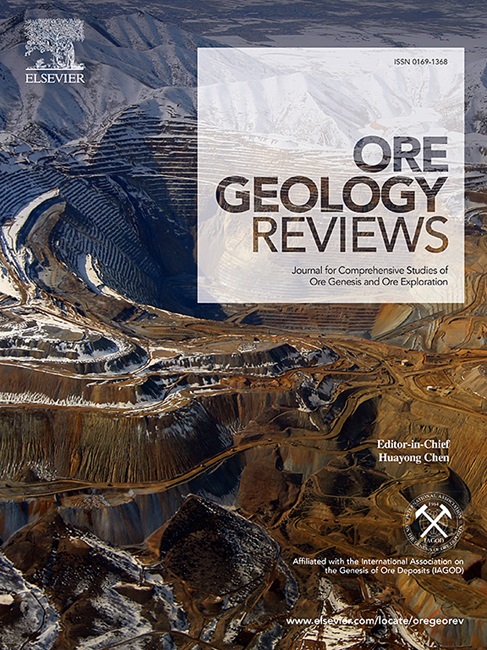Smectite as the lithium-rich mineral precursor: Key to lithium enrichment in claystone from Central Yunnan, Southwest China
IF 3.2
2区 地球科学
Q1 GEOLOGY
引用次数: 0
Abstract
Investigating Li-rich claystone associated with bauxite series holds significant potential for establishing a new type of sedimentary Li resource. Recent advancements in mineralogical and geochemical studies have provided foundational findings, yet the specific Li-bearing mineral remains controversial, impeding a comprehensive understanding of the Li enrichment processes. In this study, Li-rich claystone from the Early Permian Daoshitou Formation in the Xiaoshiqiao area in Central Yunnan, Southwest China, is examined to explore the mineralogical composition, Li distribution, and formation mechanism of Li-rich mineral. In-situ analyses reveal that cookeite (chlorite group) is the primary Li-rich mineral, characterized by an Al/Si atomic ratio in the range of 1.3 to 2 and the interplanar spacing (d002) of approximately 14 Å. Other Li-bearing clay minerals, including kaolinite, Al-rich chlorite, and chamosite, have significantly lower Li contents compared to cookeite. HRTEM analysis identifies ∼24 Å layers and interstratified 14–10 Å layers within cookeite grains, indicating that cookeite transformed from primary smectite, and corrensite acting as an intermediate product during burial diagenesis. Notably, this study initially investigates the Li distribution in ooids within oolitic claystone, showing that Li is enriched in cookeite within ooids, whereas Al-rich chlorite in the surrounding matrix is Li-poor. This suggests that Li in cookeite is primarily inherited from the smectite precursor, rather than introduced through subsequent hydrothermal activity. This study concludes that Li-rich smectite precursors controlled the pre-enrichment of Li, and the transformation of smectite to cookeite during burial diagenesis stabilized the initially exchangeable Li.

蒙脱石作为富锂矿物前驱体:滇中粘土岩富集锂的关键
研究与铝土矿系伴生的富锂粘土岩对建立新型沉积锂资源具有重要意义。矿物学和地球化学研究的最新进展提供了基础发现,但具体含锂矿物仍存在争议,阻碍了对锂富集过程的全面理解。本文以滇中小石桥地区早二叠世稻石头组富锂粘土岩为研究对象,探讨了富锂矿物的矿物组成、分布及形成机制。原位分析表明,绿泥石是原生富锂矿物,Al/Si原子比在1.3 ~ 2之间,面间距(d002)约为14 Å。其他含锂粘土矿物,包括高岭石、富铝绿泥石和铁钼矿,其锂含量明显低于库克矿。HRTEM分析在cookeite颗粒中发现了~ 24个Å层和14-10个Å层间层,表明cookeite是由原生蒙脱石转变而来,而在埋藏成岩过程中,cornite是一种中间产物。值得注意的是,本研究初步考察了鲕状粘土岩中鲕状体中Li的分布,发现鲕状体中富含Li,而周围基质中富含al的绿泥石则缺乏Li。这表明,炊事岩中的Li主要是由蒙脱石前体继承而来,而不是通过后续的热液活动引入的。研究认为,富锂蒙脱石前体控制了锂的预富集,埋藏成岩过程中蒙脱石向沸石的转化稳定了初始交换态锂。
本文章由计算机程序翻译,如有差异,请以英文原文为准。
求助全文
约1分钟内获得全文
求助全文
来源期刊

Ore Geology Reviews
地学-地质学
CiteScore
6.50
自引率
27.30%
发文量
546
审稿时长
22.9 weeks
期刊介绍:
Ore Geology Reviews aims to familiarize all earth scientists with recent advances in a number of interconnected disciplines related to the study of, and search for, ore deposits. The reviews range from brief to longer contributions, but the journal preferentially publishes manuscripts that fill the niche between the commonly shorter journal articles and the comprehensive book coverages, and thus has a special appeal to many authors and readers.
 求助内容:
求助内容: 应助结果提醒方式:
应助结果提醒方式:


